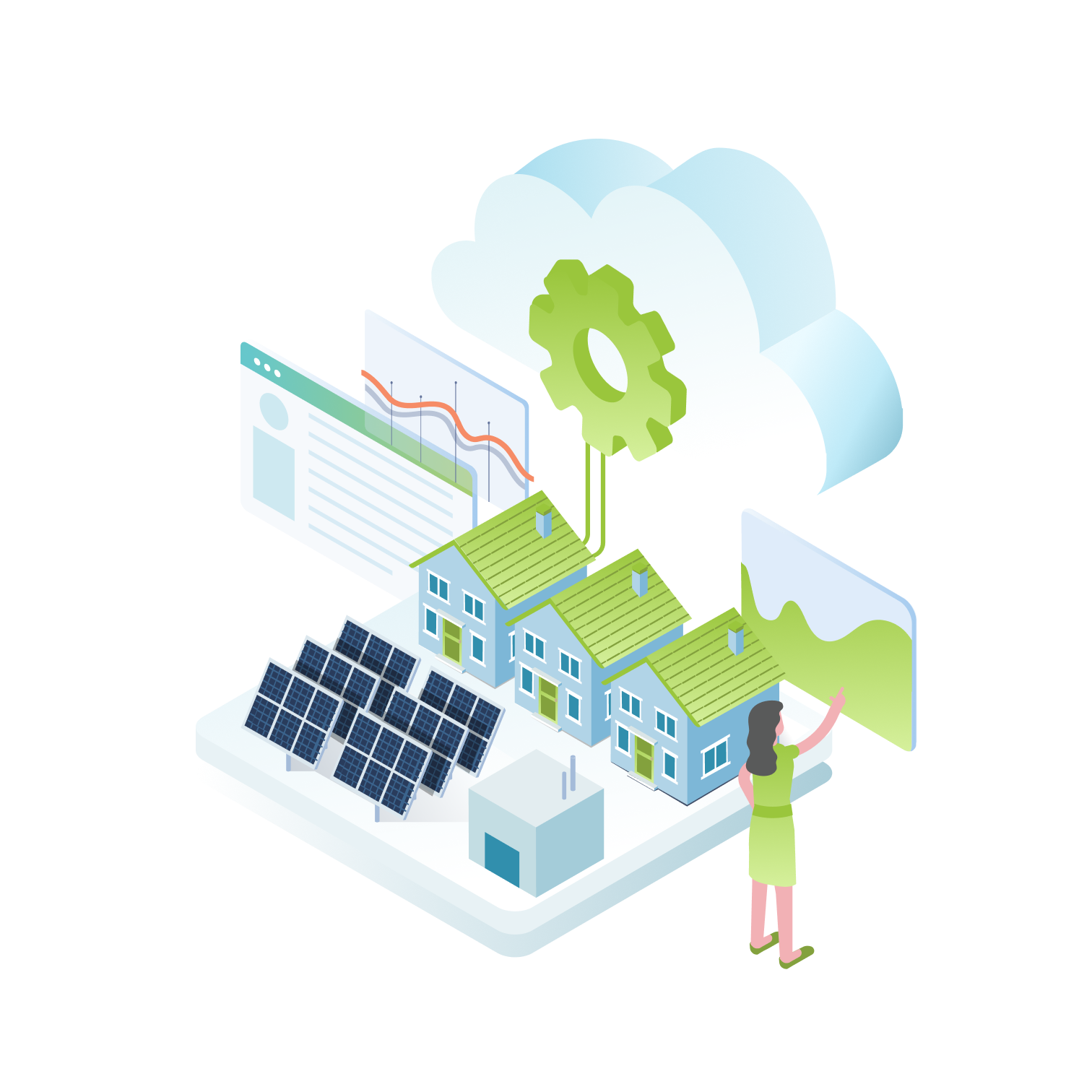Energy efficiency in office buildings years later after COVID-19

- SMART BUILDING
- ENERGY MANAGEMENT
- PROPERTIES
The COVID-19 pandemic brought about a paradigm shift in how we work, with remote work and telecommuting becoming the new norm for millions of employees worldwide. As remote work gained traction, commercial office buildings encountered reduced occupancy rates, necessitating a heightened focus on optimizing energy utilization to curtail expenses. This shift highlighted the importance of adapting office spaces to the evolving needs of a hybrid workforce.  The COVID-19 pandemic introduced a new normal marked by strict lockdowns and lifestyle changes. One of the most noticeable shifts was the surge in remote work and telecommuting practices, which still prevail years after the initial outbreak. Offices, once bustling hubs of activity, now grapple with fluctuating occupancy patterns and shifting energy requirements, as remote work becomes a long-term outcome of the pandemic.
The COVID-19 pandemic introduced a new normal marked by strict lockdowns and lifestyle changes. One of the most noticeable shifts was the surge in remote work and telecommuting practices, which still prevail years after the initial outbreak. Offices, once bustling hubs of activity, now grapple with fluctuating occupancy patterns and shifting energy requirements, as remote work becomes a long-term outcome of the pandemic.
In the wake of the lockdowns, various sectors experienced disruptions, with the economy witnessing two significant transformations. First, industries like travel, arts, and entertainment, along with personal services, ground to a complete or partial halt. Second, there was a sweeping transition from traditional in-office work to remote work from home. Governments and organizations worldwide actively encouraged or mandated remote work, resulting in a substantial portion of the global workforce embracing this new paradigm. For instance, in Canada, around 39.1% of individuals were engaged in remote work during one week in March 2020, a trend that continued into 2021, with 32% of employees in the 15–19 age group working remotely.
|
|
A study conducted by Elizabeth Buechler examined the impact of lockdowns in 58 countries and revealed that stricter lockdowns and reduced transportation mobility correlated with more significant energy savings. Notably, the most substantial energy savings were observed during the initial lockdown phase, such as Australia's 6.7% decline in electricity demand and Italy's 3–4% decrease. Javier Prol's research indicated a 3–12% reduction in electricity consumption during the first few months of the 2020 lockdown. Thus, the energy impacts of lockdowns were diverse, and uncertainties lingered regarding regional variations in energy use. |
|
Residential energy consumption in the United States exemplified this shift, showing an estimated 6-8% increase compared to the previous year. The proliferation of Information and Communication Technology (ICT) devices contributed to this trend, impacting household energy consumption and increasing demands on data centres and networks. Global internet traffic surged by nearly 40% between February and mid-April, reflecting the growing reliance on digital connectivity. Many non-residential buildings faced the challenge of adapting their energy operational schedules from full-space to partial-space operations, a transition not always achievable with existing control strategies. The long-term energy consequences of these unprecedented changes and their sustainability beyond the immediate crisis are still uncertain.
The pandemic accelerated a trend that was already gaining momentum—the acceptance of remote work and flexible work arrangements. As businesses adapt to this new way of operating, commercial office buildings face challenges that demand creative solutions. One of the most pressing issues is the need to reduce energy consumption and operational costs while maintaining comfortable and functional workspaces. As remote work gained traction, commercial office buildings encountered reduced occupancy rates, necessitating a heightened focus on optimizing energy utilization to curtail expenses. This shift highlighted the importance of adapting office spaces to the evolving needs of a hybrid workforce.
For operators, there are also well-known best practices to eliminate energy waste in buildings, such as insulation to reduce heat transfer, installing energy-efficient windows and doors, different heating, ventilation and air conditioning systems, or smart appliances, but also the installation of renewable energy systems to reduce energy dependency. Energy management systems are seen by building operators as a tool to bring the energy efficiency ecosystem together rather than as an efficiency-enhancing solution that can save them significant operating costs. In recent years, it has become essential for properties and commercial and public buildings to have building management systems. Still, these systems often do not consider the characteristics of the external and internal environment of buildings and the changes that occur in these environments. They, therefore, cannot provide comprehensive assistance in the correct use of energy.

With energy prices soaring, the current challenge for building management companies is how to manage and pass on the increased costs to their tenants, but the first step is to identify areas that are over-using energy or not optimized to the extent possible.
Grape Solutions' Erbor solution considers the external and internal environmental characteristics, creating control systems that automatically increase the efficient use of energy in the building by detecting environmental changes without human intervention, reducing the overall building operating costs associated with energy prices. The building energy management software is unique because it does not interfere with existing building management systems (e.g. production line, alarm, fire alarm), but manages only the data points necessary to implement the rule. The weather forecasting function built into the software allows the system to automatically detect how much cooling or heating is needed in a given room to avoid overcooling or overheating. Erbor will enable the building to stop using energy to cool a room to 22 degrees Celsius if a drop in outside temperature in the coming hours will automatically do so.
In conclusion, the COVID-19 pandemic ushered in profound changes that continue to shape the energy efficiency landscape of office buildings and beyond. The enduring impacts of remote work, the dynamic energy consumption patterns, and the commitment to sustainability have collectively reshaped how we design, construct, and inhabit our built environment. As we navigate this new era, optimising energy efficiency in office buildings remains crucial to creating sustainable, healthy, and adaptive spaces for the future. |
Share this post on social media:
Posts by Tag
- IoT (17)
- Smart cities (16)
- E-mobility (14)
- Energy Management (10)
- Mobility (9)
- Software development (9)
- Marketing automation (6)
- RPA (6)
- Robotic Process Automation (6)
- electric vehicles (6)
- Internet of Things (5)
- IoT solution (5)
- Marketing software (5)
- Smart Building (5)
- Business Intelligence (4)
- Custom applications (4)
- IoT platform (4)
- Uipath (4)
- electric charging (4)
- IoT devices (3)
- Properties (3)
- AI (2)
- BI (2)
- Montu (2)
- Multi-device functionality (2)
- Omnichannel (2)
- RPA Budapest (2)
- Smart city (2)
- UX design (2)
- app development (2)
- artificial intelligence (2)
- crm (2)
- crm software (2)
- electric charging station (2)
- machine learning (2)
- marketing campaign (2)
- optima (2)
- API Testing (1)
- Agriculture (1)
- Automated Testing (1)
- BYOD (1)
- EV (1)
- Energy Communities (1)
- Event insights (1)
- Event report (1)
- Green IoT (1)
- HR (1)
- IT Outsourcing (1)
- ML (1)
- Power BI (1)
- Resource Management (1)
- Smart Home (1)
- Smart Office (1)
- TaaS (1)
- UX/UI Design (1)
- Xamarin (1)
- cloud (1)
- cloud computing (1)
- cross-selling (1)
- data driven marketing (1)
- digital twin (1)
- dynamic customer segmentation (1)
- esg (1)
- inbound marketing (1)
- industry 4.0 (1)
- onprem (1)
- onpremise (1)
- scalability (1)
- software robot (1)
- testing as a service (1)
- upselling (1)
Recent Posts
Read On

- SMART BUILDING
- ENERGY MANAGEMENT
- PROPERTIES
Green building tech trends that are shaping the construction industry
The construction industry plays a significant role in environmental degradation, meaning that sustainability and green solutions are fundamental in improving our lives' environmental, economic, and societal aspects. Green buildings present an alternative method to reduce the environmental impact of...

- IOT
- E-MOBILITY
- ENERGY MANAGEMENT
- SMART CITIES
4 ways software solutions can help companies' decarbonization strategies
Decarbonization, the process of reducing or eliminating harmful emissions, has emerged as a central focus in our collective efforts to combat climate change and pave the way for a more sustainable and environmentally friendly future. Software solutions play a crucial role in supporting companies'...

- SMART BUILDING
- ENERGY MANAGEMENT
- PROPERTIES
Energy management software for properties and buildings
Buildings encounter multiple challenges in today's fast-paced world, necessitating cost-effective and creative solutions. With expanding urbanization, increasing energy demand and environmental concerns, buildings must evolve to meet changing requirements while minimizing their resource consumption...



